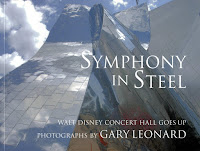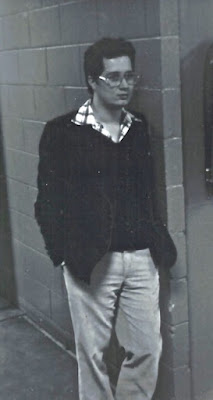To those not familiar with photographer Gary Leonard, you must be new in town. Welcome to L.A.
His accomplishments are incomparable.
And for forty years
his photos must have been preparing
Angelenos for the invention of the Selfie.
Early L.A. Punk Music
The momentum to monumentally document Los Angeles for Gary perhaps started with the L.A. punk music scene, reflected in his select photo contributions to the 1997 book
Make the Music Go Bang! edited by Don Snowden. Most of his shots contained there date from 1980 and 1981. In recollecting those years to this blogger, Gary was not an outsider looking in – he said “the point is that I was not just studying the natives, I am a native.”
The man behind the camera never stood the chance to remain facelessly anonymous. Though one could not call him greGaryous, his omnipresence and mindful manner has made him a friend to many.
His job assignments at the local papers send him to the heart of the action, such as by his current employers,
Los Angeles Downtown News and the online
LA Observed. The latter provides a regular
"Take My Picture Gary Leonard" web feature for his takeaways from the streets and people of the city. "Take My Picture Gary Leonard" had been featured too at previous papers,
L.A. Reader and
L.A. New Times.
Gary Sees Us Equally, Honestly
He wrote in the introduction of his 2003 book
Symphony in Steel: Walt Disney Concert Hall Goes Up “…I’ve shot upwards of a million images of my hometown. My archives are filled with politicians, punk rockers, groundbreakings, cult conventions, political conventions, the famous, infamous and un-famous…”
A chapter in
Make the Music Go Bang! provided this observation from musician Exene Cervenkova: “Gary Leonard took the photos back then the same way he does now. He sees something and becomes instantly connected to it.” “And this is the best thing left from those days; because these pictures and some big black records you probably haven’t heard are honest. Honest, faithful and endowed with the lives that are gone.”
City of the Angels
In recent years, Gary has put angels back in the city name.
 |
| (This photo and all images below taken by E. Uyeda unless otherwise noted) |
An Interview Via Email
Q: During the 1992 L.A. Riots, you were out there documenting those tense days. Many of your photos appear to be taken from the street, such as among moving cars. Were you mostly shooting while in a vehicle?
GL: I did much of the shooting while standing up through the sunroof in a late model Volvo Sedan.
Q: So you were driving the Volvo, or you had a driver?
GL: Anne Stein drove her Volvo while me and my 15 year old son took pictures.
Q: Were you apprehensive about the state of volatility, that someone might be ticked off feeling exploited by a stranger pointing a camera?
GL: No. My thoughts were all about getting the shots.
Q: This may sound like a police interrogation, but nearly six years earlier, where were you the morning of April 29th, 1986, when the fire broke out at the Los Angeles Central Library?
GL: I was having breakfast at Millie’s diner on Sunset in Silverlake.
Q: Was 1986 a different mindset - we didn't have instantaneous communications - you were not aware of it? You did not take any photos of the fire then?
GL: I did not photograph the library.
Q: You have donated thousands of your photographs to the Los Angeles Public Library. You once said that you wanted to give back to the institution that you greatly benefited. Can you elaborate on what the library has meant to you?
GL: studying the photo collection, meeting and getting to know the Librarian Carolyn Kozo Cole put me on the path. Here was a place for me to add photographs from my time for the future generations interested in times gone by here in L A.
Q: Is there a meaning for your signature on your photographs “X: Gary Leonard”?
GL: it’s my trademark. It means “product of”.
Q: Who was the first person you photographed with the angel wings?
GL: my friend Francisco Siqueiros. He is an Artist and master printer. His shop, El Nopal, is at 109 West 5th.
Q: At sports events you have been inspired by the energy of the crowds, such as photographing the spectators as they sang the national anthem. How do you personally feel about Randy Newman’s song “I Love L.A.”?
GL: I like how it’s a native view.
Q: Have you photographed Dodgers fans specifically when that song is played?
GL: that’s a good idea but the thing about the national Anthem is you can see it because people have their hands over their hearts.
"Los Angeles Town"
It seemed appropriate to ask Gary (who apparently loves L.A.) about the Randy Newman song. “I Love L.A.” was released in 1983, and then the next year the Summer Olympics arrived in Los Angeles.
Newman’s songwriting genius tapped into something intangible for a hometown pride song, though the requisite allusions are there - car culture, the boulevards, the Beach Boys, the geography, the girls. But, in Newman fashion, he hinted at the dismal also, perhaps of urban socioeconomic ills.
The song became bigger than Newman in more recent years when sports stadiums adopted its cheerful connotations and used it to inspire rousing crowds as their teams scored big.
Several years early, in 1981, there was another city song to commemorate the bicentennial celebration ringing in 200 years since the founding of L.A. in September, 1781. “Los Angeles Town,” by Oklahoma-born, Florida-based Watie Riley Pickens and Bobby Lee Cude, may have gotten some mileage through middle and high school bands when the duo sponsored a school district (LAUSD) competition.
As in "I Love L.A." the Pickens-Cude song also references a street, “Figueroa’s never shut down.” It also touts “see where millions come to play, see why they all love L.A.” “You ain’t seen nothin, they all say! Not until you’ve seen L.A.” Archival materials about this song's undertaking can be researched at the
Seaver Center for Western History Research at the Natural History Museum.
Archivally Speaking
 |
Discussing archival collections in the
Seaver Center for Western History Research, which happens
to be the oldest, publicly accessible historical archive in the city,
located in the Natural History Museum.
Pictured with Gary are staff archivists Brent Riggs and John Cahoon.
|
 |
| Some of Gary's stuff in his own archival space |
L.A. Central Library
 |
October 13th, Tom LaBonge and Gary
at the 25th anniversary of the reopening of the Central Library |
Former city councilman Tom LaBonge and Gary are both active donors of their own photographs to the L.A. Public Library's photo collection.
As Gary revealed in the Q&A above, it was from learning about the work of Carolyn Kozo Cole at the library that led him to be "photo-anthropic." Librarians enlisted the community to delve into their private family photograph archives and donate copies. The 1991 Shades of L.A. project grew out of an awareness that there existed a large void in the visual record of the lives of ordinary citizens in a diversely inhabited region.
Photographing GARY LEONARD Photographing
 |
Capturing the conversations with Monsignor Francis J. Weber
March, 16, 2018
|
 |
| A visit to the Seaver Center June 12, 2018 |
 |
A three-camera-toting assignment at the Mark Taper Auditorium
featuring author Stephen Gee and architect Norman Pfeiffer.
October 13, 2018, 25th anniversary of the reopening of the Central Library |
 |
| (Click on image for enlargement) |
Bukowski Photographing
German-born poet and writer Charles Bukowski (1920-1994) lived most of his life in Los Angeles. His body of work, like Gary's, was honest and shaped by the city. Bukowski credited his creative streaks to wine, beer and solitude.
But his mention here also offers a contrast to Gary Leonard's impulses, in that Gary's art has been achieved by solidarity.
And Gary's portraits and visual compositions provide a means for a more tolerant Los Angeles.
 |
| Courtesy PBA Galleries Auctioneers & Appraisers |
In Closing
 |
A two-camera day visiting the Archival Center for the Archdiocese of Los Angeles
at Mission San Fernando, March 2018 |
Update 11.9.2024: check out Gary's pet project in documenting the construction of the 6th Street Bridge (Viaduct).













































































